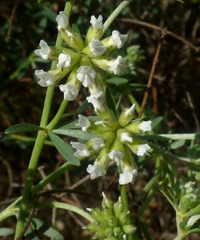Navelwort
Umbilicus rupestris
Umbilicus rupestris, commonly known as Venus' navel, navelwort, or in Spanish, ombligo de Venus, is a distinctive plant species found within the Comunidad Valenciana and throughout the Mediterranean region. Its unique appearance makes it easily identifiable and an intriguing addition to the local flora.
- Appearance: Umbilicus rupestris is characterized by its fleshy, succulent leaves that resemble a shallow navel, hence its name. The leaves are usually round or kidney-shaped and often display a slightly glaucous hue.
- Flowers: During its blooming period, the plant produces tall, slender stems adorned with small, bell-shaped, greenish-yellow flowers. These flower spikes can reach up to 30 cm in height, towering over the basal rosette of leaves.
- Habitat: This species is typically found in rocky crevices, stone walls, and shaded, moist areas. It thrives in well-drained soils, often making its home where other plant species might struggle, such as in the cracks of old stone buildings and cliffs.
- Distribution: Although native to the Mediterranean, including the Comunidad Valenciana, Umbilicus rupestris has adapted to various other regions with similar climates. Its resilience makes it a common sight in areas where its preferred rocky habitat is present.
The intriguing appearance and adaptability of Umbilicus rupestris make it a valuable and beautiful component of the natural landscape in the Comunidad Valenciana. Its ability to thrive in less hospitable environments highlights the diverse range of flora found in this region.







